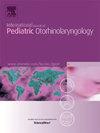Transforming pediatric ENT documentation: Efficiency, accuracy, and adoption of speech recognition technology (Speaknosis)
IF 1.2
4区 医学
Q3 OTORHINOLARYNGOLOGY
International journal of pediatric otorhinolaryngology
Pub Date : 2025-02-19
DOI:10.1016/j.ijporl.2025.112275
引用次数: 0
Abstract
Introduction
Efficient and accurate medical documentation ensures patient safety, continuity of care, and clinician satisfaction. Speech recognition technology has emerged as a promising alternative to traditional documentation methods, potentially reducing administrative burden and improving workflow efficiency. However, concerns about accuracy, consistency, and clinical adoption remain significant barriers to its integration into medical practice.
Objective
This study evaluates the impact of AI-powered speech recognition technology (Speaknosis) on medical documentation in pediatric ENT settings, focusing on its efficiency, accuracy, and acceptance among clinicians. The research also explores the tool's potential to enhance clinical data interpretation and decision-making.
Methods
Ten pediatric ENT physicians participated in 375 AI interactions, and a quasi-experimental design was employed. Speaknosis-generated documentation was assessed for semantic relevance (BERTScore), quality (PDQI-9), and clinician satisfaction using a 5-point Likert scale. Human interventions were analyzed for error correction and alignment with professional standards. Statistical analysis of quantitative data and thematic evaluation of qualitative feedback were conducted.
Results
The AI system achieved a high average BERTS score (96.50 %), with notable instances of inaccuracies requiring human intervention, including omission of clinical findings, redundant content, and formatting issues. The PDQI-9 mean score was 38.34, indicating overall high-quality documentation, with strengths in organization (mean = 5.0) and internal consistency (mean = 4.83). However, comprehensiveness (mean = 3.99) and timeliness (mean = 4.00) exhibited variability. Clinician satisfaction averaged 4.64, with higher satisfaction rates correlated to interactions with superior documentation quality and duration.
Conclusion
Speaknosis has the potential to improve documentation efficiency and accuracy and alleviate clinician burden. However, challenges in addressing error variability and comprehensiveness highlight the need for ongoing algorithm refinement and human oversight. This study emphasizes the transformative role of AI in healthcare documentation, contingent on robust validation and strategic implementation.
改变儿科耳鼻喉科文件:效率、准确性和采用语音识别技术(Speaknosis)
高效、准确的医疗记录确保了患者的安全、护理的连续性和临床医生的满意度。语音识别技术已经成为传统文档方法的一种有前途的替代方法,有可能减轻管理负担并提高工作效率。然而,对准确性、一致性和临床采用的担忧仍然是将其纳入医疗实践的重大障碍。目的本研究评估人工智能语音识别技术(Speaknosis)对儿科耳鼻喉科医疗记录的影响,重点关注其效率、准确性和临床医生的接受程度。该研究还探索了该工具在增强临床数据解释和决策方面的潜力。方法10名儿科耳鼻喉科医生参与375次人工智能互动,采用准实验设计。使用5分李克特量表评估speaknosis生成的文档的语义相关性(BERTScore)、质量(PDQI-9)和临床医生满意度。对人为干预进行了分析,以纠正错误并与专业标准保持一致。对定量数据进行统计分析,对定性反馈进行专题评价。结果人工智能系统取得了很高的平均BERTS分数(96.50%),但存在需要人工干预的显著不准确情况,包括遗漏临床发现、冗余内容和格式问题。PDQI-9平均得分为38.34分,表明整体文献质量高,在组织(平均值= 5.0)和内部一致性(平均值= 4.83)方面具有优势。然而,综合性(平均值= 3.99)和及时性(平均值= 4.00)表现出差异。临床医生的平均满意度为4.64,较高的满意度与卓越的文件质量和持续时间相关。结论speaknosis具有提高文献记录效率和准确性,减轻临床医生负担的潜力。然而,在解决错误可变性和全面性方面的挑战突出了持续改进算法和人为监督的必要性。本研究强调了人工智能在医疗保健文档中的变革作用,这取决于稳健的验证和战略实施。
本文章由计算机程序翻译,如有差异,请以英文原文为准。
求助全文
约1分钟内获得全文
求助全文
来源期刊
CiteScore
3.20
自引率
6.70%
发文量
276
审稿时长
62 days
期刊介绍:
The purpose of the International Journal of Pediatric Otorhinolaryngology is to concentrate and disseminate information concerning prevention, cure and care of otorhinolaryngological disorders in infants and children due to developmental, degenerative, infectious, neoplastic, traumatic, social, psychiatric and economic causes. The Journal provides a medium for clinical and basic contributions in all of the areas of pediatric otorhinolaryngology. This includes medical and surgical otology, bronchoesophagology, laryngology, rhinology, diseases of the head and neck, and disorders of communication, including voice, speech and language disorders.

 求助内容:
求助内容: 应助结果提醒方式:
应助结果提醒方式:


